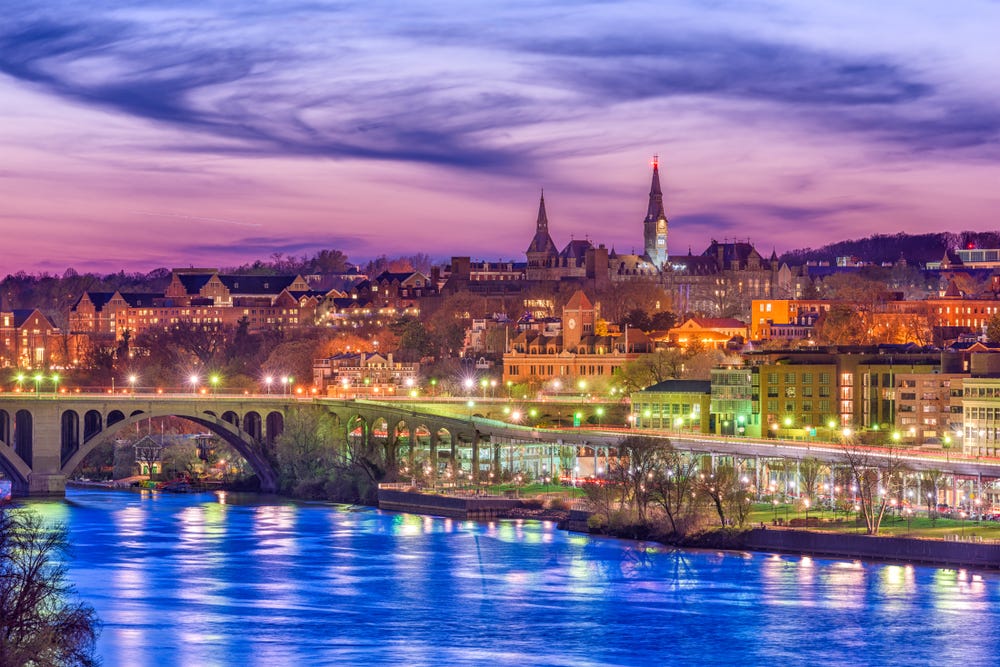As part of its 3-billion campaign, “Called to Be,” Georgetown University has been expanding its presence in downtown Washington, D.C., aiming “to expand our university’s impact in service to the common good.” Beyond the Law Center, established in 1971, recent expansions include the School of Continuing Studies at 111 Mass Avenue NW (2021), the 55 H Street graduate residence building (2022), the McCourt School of Public Policy’s move to 125 E Street (2024), and the acquisition of 77 H Street NW for a residential building with retail space.
While these developments may enhance students’ experiences and Georgetown’s programs, they also raise a critical issue: gentrification.
According to the National Institutes of Health, gentrification refers to a process where “central urban neighborhoods…experience a reversal, reinvestment, and the in-migration of a well-off middle- and upper-middle-class population.”
While it can increase property values and reduce crime rates, it often leads to residential displacement and the erosion of social networks, disproportionately impacting poorer, long-term residents. Georgetown’s expansion, through purchasing buildings and attracting new businesses, risks further disrupting existing communities.
D.C.’s History as “Chocolate City”
Washington, D.C. has long been known as the original “Chocolate City,” a term referring to its status as a majority-Black urban center and its cultural and political significance of the civil rights and Black Power periods. African American residents made up around 67 % of the city’s population in 1968. This Black-majority constituency influenced D.C.’s political landscape, including its exclusion from statehood – rooted in fears among white elites of perceived Black “domination” over the city’s economic and political systems.
Despite economic and social progress over time, Black residents have largely been left behind, driven out by rising costs and diminished economic opportunities. A 2024 Georgetown University report found a stark racial wealth gap: $240,120 gap in wealth between the median Black/African American and white household. This disparity is compounded by racial segregation, with white population concentrated in the western parts of the city and Black populations predominantly in the east.
Georgetown’s History of Gentrification
Even before the term “gentrification” was coined by sociologist Ruth Glass in 1964, D.C. had already experienced significant demographic changes. Georgetown neighborhoods underwent drastic transformation during the 1920s and 30s as white professionals moved into previously working-class areas, renovating older homes.
In the mid-20th century, as D.C. faced population decline, policymakers focused on real estate development with projects such as the new convention center, Pennsylvania Avenue, and the Metro. This led to a new wave of gentrification in Foggy Bottom and Capitol Hill during the 1950s and 1960s, where developers purchased “slum” properties at low prices, renovated them, and sold them to wealthier newcomers. The displacement of the 1970s was especially severe, with escalating rents, rising property taxes, and predatory real estate practices forcing low-income residents out of their neighborhoods.
Georgetown University’s Impact on Gentrification Today
What occurred in Georgetown’s neighborhoods decades ago now risks being repeated in downtown areas where the university continues to expand. Georgetown’s presence can drive up property values and rents, making housing less affordable for long-term and lower-income residents. The influx of students and university-affiliated individuals can also shift the local commercial landscape toward business catering to wealthier customers – such as high-end cafes, restaurants, and boutiques – displacing small, local businesses.
Georgetown’s Center for Social Justice has attempted to address housing insecurity and gentrification through staff-run programs and over 40 student organizations. Programs such as HOME (Homelessness | Meals | Education) collaborates with local nonprofits to support services through student volunteers, fundraising events, and advocacy.
However, while these efforts are valuable, the scale of the problem requires more structural measures to ensure affordable housing and equitable economic opportunities. Universities across the U.S. – such as the University of Chicago, University of Illinois, Drexel University, and University of Pennsylvania – have also been identified as contributors to gentrification, particularly in Black communities. Factors like green places and public transit further exacerbate these trends, making neighborhoods more appealing to wealthier newcomers while driving up living costs.
A Path Forward
Some universities have begun addressing their role in gentrification through community partnerships and investments. For example, Columbia’s construction of its Manhattanville campus in Harlem involved a $578 million investment toward local construction firms owned by people of color, generating more than 1,500 construction-related jobs. Under a city contract, Columbia committed to providing $20 million for affordable housing, $4 million in legal housing assistance, $20 million to the Harlem Community Development Corporation, and $76 million for community benefits.
Georgetown University’s mission statement emphasizes “our commitment to justice and the common good” and “live generously in service to others.” To uphold these values, Georgetown must take structural efforts to support the surrounding community and raise awareness about the unintended consequences of its expansion.
While universities have the power to revitalize communities, they must also recognize their capacity to harm. By actively working to mitigate the negative impacts of expansion and prioritizing genuine partnerships with affected communities, Georgetown University can help create a more just and equitable community.






